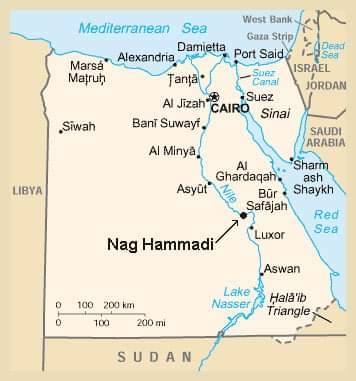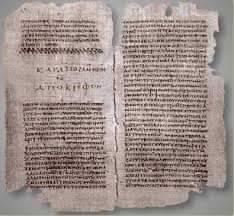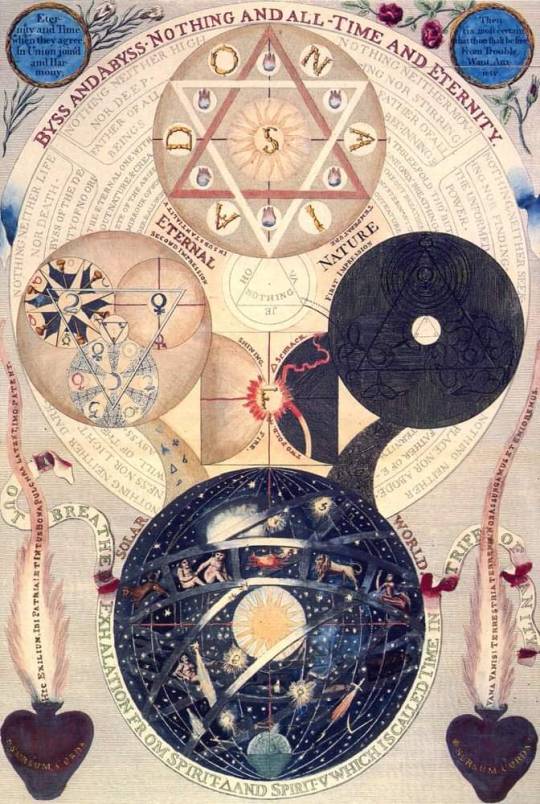#Nag Hammadi codices
Explore tagged Tumblr posts
Text
Ascended Master Mary Magdalene ~ The Gospel of Mary ~ Pearls of Wisdom
The Gospel of Mary (Magdalene) in The Nag Hammadi Scriptures, Codex BG8502,1, begins with The Nature of Sin and the Good (7,10-8,11). Peter is asking Jesus postresurrection, “… What is the sin of the world?” Jesus replied, “There is no such thing as sin, rather, you yourselves are what produce sin when you act in accordance with the nature of adultery, which is called ‘sin.’ For this reason, the…

View On WordPress
#ascended master#darkness#desire#Eternal Universal Life Force Energy#God#Gospel of Mary#ignorance#Jesus#Karen L. King#Lent#Luke 17:20-21#Mary#Mary Magdalene#meditation#Nag Hammadi#Nag Hammadi codices#Nag Hammadi Gospels#nature of sin#post ressurection#postresurrection#Resurrection#sin#soul#The Savior&039;s Farewell#wrath
1 note
·
View note
Text
I have been reading the Nag Hammadi codices off and on since 2022. I have to be in the right kind of mood to try and figure out what the fuck the authors are trying to say, then recall my own knowledge of the Bible (unfortunately, I am very rusty 🫠). I wish I had this book in physical form so I could switch back and forth between documents. I am convinced this is what they made those big-ass book wheels for.
Finally. Finally I get baby's first gnosis: Exegesis on the Soul. It's meant to spread more awareness of gnosticism, so it's much clearer, without seventeen Adams and Sophias running around.
I really appreciate it, ok.
Why do we have multiple copies of each character, you may ask? There are so many reasons but mostly it's to piss me off, I think.
3 notes
·
View notes
Text
youtube
Gnostics, Part One, BBC Documentary
In 1945 an Egyptian peasant discovered a collection of early Christian scriptures - the Nag Hammadi Codices, which revealed the existence of a Gnostic version of Christianity…"
gnosis
spirituality
#gnostic#gnosticism#christian mysticism#mysticism#mystics#mystic christianity#nag hammadi library#Youtube
7 notes
·
View notes
Text

The Nag Hammadi Codices: The Lost Scrolls of Gnostic Christianity
The Nag Hammadi Codices are a collection of ancient religious texts discovered in 1945 near the Egyptian town of Nag Hammadi. These codices contain a variety of Gnostic texts, offering insight into early Christian beliefs and practices that diverged from mainstream Christianity. The discovery of the Nag Hammadi Codices shed new light on the diversity of early Christian thought and spirituality.

One of the most well-known texts found in the Nag Hammadi Codices is the Gospel of Thomas, a collection of sayings attributed to Jesus. Unlike the canonical Gospels, the Gospel of Thomas is a non-narrative text that presents the teachings of Jesus in the form of aphorisms and parables. This gospel emphasizes a spiritual understanding of the teachings of Jesus and the importance of inner transformation.

The Nag Hammadi Codices also contain texts such as the Gospel of Philip, the Gospel of Mary, and the Apocryphon of John, each offering unique perspectives on Gnostic theology and cosmology. These texts explore themes such as the nature of the divine, the problem of evil, and the role of gnosis, or spiritual knowledge, in achieving salvation.

The importance of the Nag Hammadi Codices lies in their contribution to our understanding of the diversity of early Christian thought and the complex relationship between Gnostic movements and mainstream Christianity. These texts provide valuable insights into the beliefs and practices of early Christian communities that subscribed to alternative interpretations of Christian doctrine.
The Nag Hammadi Codices remain significant today for scholars of early Christianity, Gnosticism, and religious studies. They offer a window into a formative period in the history of Western spirituality and challenge traditional narratives about the development of Christian theology. By studying the Nag Hammadi Codices, we can gain a richer appreciation of the complexity and creativity of early Christian thought and the enduring legacy of Gnostic spirituality.
Thank you for reading. If you enjoyed this content consider liking, commenting, or following for more content.
Sources:
- "The Nag Hammadi Library" edited by James M. Robinson
- "The Gnostic Gospels" by Elaine Pagels
- The Gnostic Society Library website: https://gnosis.org/naghamm/nhl.html
2 notes
·
View notes
Text
proud writer of the genius annotation for the nag hammadi codices
10 notes
·
View notes
Text
currently working on a project about the nag hammadi codices and I think you already know what I’m thinking about
#could I have chosen any number of other paper topics? yes. but why would I have wanted to?#we would just be walking around nag hammadi etc etc
4 notes
·
View notes
Text
Thomas, Twin Of Jesus by Stewart Swerdlow
Thomas, Twin Of Jesus by Stewart Swerdlow
Read this interesting article that confirms what I have told you.
In the mid-20th century, a groundbreaking discovery shook the world of biblical scholarship and religious history! Ranker reports that two farmers in Nag Hammadi, Egypt, stumbled upon a treasure trove of ancient manuscripts that would forever alter our understanding of early Christianity.
Known as the Nag Hammadi Library, this astonishing compilation consisted of at least 50 previously unseen gospels and codices, each a window into early Christians’ myriad beliefs and practices. Read more
Not a member join us day for less than $1 a day and get access to Stewart's and Janet's blogs
https://www.expansions.com/product-category/membership/

0 notes
Text




A number of leather codices were found at Nag Hammadi in Southern Egypt in 1945.
They are Coptic translations of Greek Gnostic documents. They likely belonged to an Egyptian monastery were disposed of after Gnostic literature was categorically rejected by decree of St. Athanasius of Alexandria.
The leather bound volumes contain the following works. They are mostly Valentinian Gnostic texts that were popularized in Egypt after the second century A.D.
Codex I (The Jung Codex)
The Prayer of the Apostle Paul
The Apocryphon of James
The Gospel of Truth
The Treatise on the Resurrection
The Tripartite Tractate
Codex II
The Apocryphon of John
The Gospel of Thomas a sayings gospel
The Gospel of Philip a sayings gospel[citation needed]
The Hypostasis of the Archons
On the Origin of the World
The Exegesis on the Soul
The Book of Thomas the Contender
Codex III
The Apocryphon of John
The Gospel of the Egyptians
Eugnostos the Blessed
The Sophia of Jesus Christ
The Dialogue of the Saviour
Codex IV
The Apocryphon of John
The Gospel of the Egyptians
Codex V
Eugnostos the Blessed
The Apocalypse of Paul
The First Apocalypse of James
The Second Apocalypse of James
The Apocalypse of Adam
Codex VI
The Acts of Peter and the Twelve Apostles
The Thunder, Perfect Mind
Authoritative Teaching
The Concept of Our Great Power
Republic by Plato [The original is not gnostic, but the Nag Hammadi library version is heavily modified with current gnostic concepts.]
The Discourse on the Eighth and Ninth – a Hermetic treatise
The Prayer of Thanksgiving (with a hand-written note) – a Hermetic prayer
Asclepius 21-29 – another Hermetic treatise
Codex VII
The Paraphrase of Shem
The Second Treatise of the Great Seth
Gnostic Apocalypse of Peter
The Teachings of Silvanus
The Three Steles of Seth
Codex VIII
Zostrianos
The Letter of Peter to Philip
Codex IX
Melchizedek
The Thought of Norea
The Testimony of truth
Codex X
Marsanes
Codex XI
The Interpretation of Knowledge
A Valentinian Exposition, On the Anointing, On Baptism (A and B) and On the Eucharist (A and B)
Allogenes
Hypsiphrone
Codex XII
The Sentences of Sextus
The Gospel of Truth
Fragments
Codex XIII:
Trimorphic Protennoia
On the Origin of the World
1 note
·
View note
Video
youtube
Liked on YouTube: How a Gnostic Book Combined Ancient Mystery Schools - Nag Hammadi Codex VI || https://www.youtube.com/watch?v=6ygAsMjgnOY || The Egyptian Gnostic Manuscript Library found in 1945 has transformed how we think about ancient Philosophy and Spirituality. Among those 12 codices is one more mysterious than all the others. Nag Hammadi Codex VI combines tales of Jesus as the angelic healer Lithargoel, narratives about the salvation of the soul in history, paradoxical utterances of an androgyne deity, the defeat of the persecuting Imitator by "Our Great Power" and several texts of profound Hermetic Wisdom and even a dash of Plato. In this episode I explore what is perhaps the most perplexing collection of ancient mystery wisdom to survive from antiquity. Consider Supporting Esoterica! Patreon - https://ift.tt/P9zanK7 Paypal Donation - https://ift.tt/tfey0jH Merch - https://www.youtube.com/channel/UCoydhtfFSk1fZXNRnkGnneQ/store #gnosticism #occult #hermetica Nongri's Blog on Nag Hammadi VI - https://ift.tt/P6geCmJ " - God's Library: The Archaeology of the Earliest Christian Manuscripts - 978-0300248609 The Nag Hammadi Scriptures - 978-0061626005 Hanegraaff - Esotericism and the Academy - 978-1107680975
0 notes
Text
The Nag Hammadi Library: Uncovering the Secrets of Early Christianity and Gnosticism
youtube
The Nag Hammadi library is a collection of thirteen ancient codices, which were discovered in Upper Egypt in 1945. These codices contain a total of 52 texts, including gospels, acts, letters, and apocalyptic writings. The Nag Hammadi library is one of the most important discoveries of the 20th century, and it has shed new light on early Christianity and Gnosticism.
What makes the Nag Hammadi library so fascinating is the fact that it was buried for over 1,500 years, and it survived intact. The codices were found by a group of farmers who were digging for fertilizer near the village of Nag Hammadi. They discovered a large jar that contained the codices, and they sold them to a local dealer.
The dealer recognized the value of the codices and contacted a scholar at the Coptic Museum in Cairo. The scholar arranged for the purchase of the codices, and they were eventually transferred to the Gnostic Society Library in California, where they were translated and published.
One of the most interesting aspects of the Nag Hammadi library is the fact that it contains several gospels that were not included in the New Testament. These include the Gospel of Thomas, the Gospel of Philip, and the Gospel of Truth. These gospels offer new insights into the teachings of Jesus and the early Christian community.
Another fascinating aspect of the Nag Hammadi library is the fact that it contains several texts that are related to Gnosticism. Gnosticism was a religious movement that flourished in the 2nd and 3rd centuries AD, and it was considered heretical by the orthodox Christian church. The Nag Hammadi texts offer a glimpse into the beliefs and practices of this movement.
Overall, the Nag Hammadi library is a treasure trove of ancient texts that offer new insights into early Christianity and Gnosticism. The discovery of these codices was a watershed moment in the history of religious studies, and they continue to be a source of fascination and intrigue for scholars and laypeople alike.
Nag Hammadi #early Christianity #Gnosticism #ancient texts #Gospel of Thomas #Gospel of Truth #religious studies
0 notes
Link
0 notes
Text
Ah. Life is so fucked up.
I have been leaping back and forth between YA novels, Ayn Rand, the Nag Hammadi codices, and nonfiction about Nazi occultism. I needed something to take me out of current day troubles and instead I keep drawing parallels to them. Rand's nasty, brain-dead life philosophy standing foundationally beneath the evangelical conservative movement; the hatred of women baked into an entire mythology; the historical treatment of both orthodox and gnostic Christians, by each other and by the Romans, with no one just letting people live their goddamn lives as they see fit; the creation of a social environment ripe for tyranny. Ahhhhhhh. AHHHHHHHHHHH
And then I tried to read through the Earthsea books to feel good again and Ursula K. Le Guin starts getting more and more serious and more and more grounded and I'm like. Lady. Lady please. I need to fly right now. I mean good job but I'm dying
So I should try some other YA or find another author, right? Well, I'm drawing a blank. If you have any suggestions for light-hearted, well-written work, I would gladly accept them. I need to leave the universe for a bit.
4 notes
·
View notes
Text
From the Guardian perspective, the origination of authentic ancient Gnosticism is sourced from the Essene, Christos Templar lineages that brought their Maji King Grail Lines through the Stargates to form the 12 Tribes. These lineages would hold one section of the genetic DNA blood record that contained the intelligent information of the Cosmic Law of One records, that sourced from the Krystal Universes, in the God Worlds. Each of the original Essene 12 Tribe lineages were seeded through the planetary stargate system, and helped to embody specific DNA coding that was to be initiated, accreted and integrated throughout the planetary grid network to gradually support spiritual ascension. This was the evolutionary plan in order to retrieve lost and fractured human soul groups, to repair and activate dormant DNA that occurred as a result of the Taran explosion, and subsequent wars with other species that resulted in the Luciferian Rebellion and Atlantian Cataclysm.
Since the Luciferian Covenant was made on the earth there has been an ongoing battle for this knowledge, in which the true ancient wisdom keepers were consistently hunted down and massacred. A major timeline trigger event began with the Celtic invasions 9,500 years ago, when the NAA and Illuminati groups attempted to create a super-race of genetic elites. This placed hijacked Ruby Sun DNA, through their propagated lines which evolved into Freemasonry, Knights Templar, Rosicrucian’s, Jesuits, and other secret societies that persist with a similar hermetic esoteric knowledge that is primarily used in the negative polarity of Service to Self. In the historical timelines, they targeted 2nd Stargate Grail lines for hijack or elimination, because this soul group is genetically connected to the Family of Michael that originate from Aldebaran. They are the natural Guardians of the Eastern direction grid network, as well as opening the access into the Golden Gate. These particular Michael-Nephilim bloodlines are the original authentic genetic lines of Ruby Sun DNA bodies on earth, that the NAA groups coveted and modified as host bodies for a variety of the invading Orion and Nordic groups.
Thothian groups took sections of the Essene Law of One knowledge and fashioned the Hermetic traditions, which were presented as non-Christian lineages of Gnosticism known as the Corpus Hermetica. Secret societies continued to form around the Hermetic tradition in Mystery Schools, which were used to hide the ancient knowledge from the common people, who were instead given opposing information in the form of religious indoctrination as a replacement. To cover up the Essene Christos Templar origins and mission, the NAA strongly influenced the revisions to sacred texts during the Council of Nicea. They further influenced other world religions to replace the authentic Gnostic information, with the intentional spreading of violent religions based on satanic blood sacrifice, holy wars and worshipping Alien False father Gods.
Later on, Aleister Crowley and subsequent satanic cults integrated some of this same knowledge, such as the Gnostic Mass information into their black magic rituals. Satanic cults focused on the same consciousness principles with an important caveat, as the first law for the Satanist is the Law of Reversal, in which blood sacrifice was required for perpetuating anti-life forces. All Laws would be inverted and their principles used in reverse, for the conjurer to extract power over others in the material world.
As a result of the genocidal agendas, the remaining Essene groups went underground and this knowledge was hidden and continued to be passed on in secret, such as to the Cathar sects. Some of those remaining records are within the contents found in the Nag Hammadi, to which the public has only been given limited access to partial information. The Nag Hammadi Library is a collection of thirteen ancient books called codices that contain over fifty texts, discovered in upper Egypt in 1945. This immensely important discovery includes a large number of primary Gnostic Gospels, texts thought to have been entirely destroyed. The discovery and translation of the Nag Hammadi library, initially completed in the 1970's, provides a major re-evaluation of defining the nature of Gnosticism in relationship to the authentic history of true Christianity.
Hermeticism stems from the Thothian distortion, and is a school of ideas and systems that focuses on the pursuit of Gnosis, the pursuit of direct knowledge and experiences that pertains to the inner revelation of spiritual mysteries. However, as with all knowledge and tools, they can be used in the negative polarity of Service to Self, or in the positive polarity of Service to Others. Whatever polarity we choose and use the Natural Laws to co-create with, will directly initiate how that content expresses from the original intention we have given it. The polarity we choose and its expression will have an internal and external effect, a correspondence made upon the results that we have created in our manifestation. If we are spiritual adepts and truth seekers on the path of the Law of One, our love will translate into pure knowledge given in alignment to serve our sovereignty and spiritual freedom, and we will organically manifest more goodness and natural order. If we are on the path of Service to Self, seeking material power, our fear will translate into ignorance which aligns with confusion and control, and we organically manifest more chaos and evil. When we are clear about the Natural Laws and we look to the globalscape, it is the clear result from the Controllers continual abuse of knowledge, the abuse of hidden technology used by human and nonhuman factions, resulting from the abuse of the Natural Laws in the negative polarity, Service to Self.
(Source)
1 note
·
View note
Text
As wonderful as world scriptures and the writings of past mystics might be, they are no substitute for a living spiritual path with us now in the world today, or being mentored by living spiritual teachers in-the-here-and-now. When we read one of our favorite spiritual books, perhaps representing the writings of some author who lived decades ago, centuries ago, or scriptures composed millennia ago, those old writings are held prisoner by what we ourselves are willing or able to see. Typically, human beings have no awareness beyond their current state of consciousness. We see what we already know, and anything beyond remains invisible to us. There’s always the danger of making best-selling spiritual books, writings from saints of the past, or scriptures into sock puppet gurus telling us what we want to hear. If we just unknowingly live with our blind spots, the-sages-of-the-ages will never disagree with us, will never push our boundaries, just parrot back to us what we think we already know.
On the Outside In Search of An Inside
In many cases, spiritual movements and mystic schools of spirituality are no longer with us, are defunct. Or we may find examples of groups and orders that are still around but in-name-only, have been corrupted over time, no longer what they once were. If spiritual experience is the desired goal, going on an archaeological dig sifting through the sands of time is not going to help.
I remember so well looking at my collection of mystic books and Nag Hammadi codices realizing I had reached a kind of dead end, a sense that no further progress can be made without contact with a living version of those paths with us now in the Twenty-First Century, a living gnosis now. The actual spiritual practices, East and West, are typically never written down anyway but remain private communications only between master and disciple. With past saints we can’t sit at their feet, ask questions, take notes, or learn from them the secrets of contemplative meditation practice.
“Seek to see the Living One while you are alive, lest you die and then try to behold that one — and you will be unable to see.” (Gospel of Thomas, 52)
Rather than a vain attempt to figure out the methods of meditation by randomly perusing through old writings and scriptures of those who have left-the-body decades or centuries ago speculating on what their meditation techniques might have been, in Sant Mat (The Path of the Masters) the methods of sadhana (spiritual practice) are directly communicated from one generation to the next via the Living Masters of the time.
Swami Santsevi Ji Maharaj: “As long as we are so deluded because of our ignorance we are unable to have direct knowledge of the Divine. Through the senses we recognize the body, but we cannot recognize the soul through these same senses. We declare that our physical possessions are ours, but even as we claim this we realize they are not really part of us. The truth is we are not those possessions. We are different from these things. Similarly, when we say ‘my hand’, ‘my eyes’, ‘my nose’, and so forth, do we mean that we are those bodily parts? Of course we do not mean that. They all are ours and we are the owner. We then ask how we can recognize the divine soul. The answer lies in this illustration given by various saints: During deep sleep we are unable to have any knowledge of this physical body; however, after waking up we recall this body, our relations and possessions. In the same manner, when we are in the three states — awake, sleep, dreamless sleep — we are unable to directly perceive our inner self and the Divine [God]. The Saints tell us that there is yet a fourth state, called the Turiya, which is above the others. In this state we can directly perceive our own nature and know the Divine.
“Guru Nanak Dev affirms: ‘When there is union between the soul and God, suffering is eliminated. This union occurs by the grace of God. Once the mind is in God, then death (Kal) cannot harm a person.’
“In order to have direct knowledge of the Divine, Guru Nanak teaches that it is necessary to have a path. Such a path is only found through association with a Saint or spiritual preceptor. Without this help it is not possible to have direct knowledge of the Divine.
“Concerning this knowledge Guru Nanak proclaims: ‘Dear ones, without the spiritual preceptor (guru) knowledge and the means for attaining this knowledge cannot be obtained.’” (The Harmony of All Religions, Maharshi Mehi Ashram)
More recently, from a satsang discourse of Baba Ram Singh:
“The musk is in the deer, but it seeks it not within itself: it wanders in quest of grass.” (Kabir)
“Kabir Sahib gives an example of how we are going about our lives. It is like the musk deer. The musk deer has musk within itself, but this fragrance of the musk, it doesn’t know that it is emanating from itself. Instead, it searches at different places to try to find out where that fragrance is coming from.
“Like that, God Almighty is residing within us, but then the people, the jivas [souls], try to search for that God Almighty outside in the mountains, in the caves, in the pilgrimages, and in other forms of worship. At the time of meditation, that is what the Masters explain as to how we go within this temple that has been created by God — this temple, our body, our human body — how we go within and then, how we manifest God Almighty within. That is what is explained at the time of initiation.
“God Almighty is within this human form and whoever has manifested God Almighty has done so by going within. Nobody has been able to manifest God Almighty on the outside. And in the future also, nobody will be able to do so.
“So, like the flower has a fragrance, or the musk deer has the fragrance of musk within itself, or like there is clarified butter in milk but, without effort, one is not able to get the benefit of that, one is not able to get it. So, the path to do that is contained within this human life-form where, with the Teachings of the Masters, we leave the nine doors [of the sense organs] and come to the Tenth Door [Third Eye]. And with the Grace of the Master, we are able to see for ourselves our soul and Jyoti [Light] within.
“So, Kabir Sahib says that, ‘Despite God Almighty being within, every human being, every human form, why is it that a human doesn’t manifest God Almighty? And why is it such a rare thing? That is because they have not met an attained Satguru. They have not met a true Satguru Who shows them the Path.’ Because, outwardly, there are many gurus who teach different things — from Ashtanga Yoga to austerities, different types of austerities, or people go to pilgrimages or undertake fasting and do such other things. But these are outward and it is only a true Satguru Who shows the real Path to go within and manifest God Almighty.” (Satsang Discourses, Volume 13, August, 2022)

I remember laughing so hard when I heard a stand-up comic once doing a bit saying, “I play the guitar better than Jimi Hendrix cuz he’s dead.” Funny yes, but you know, they do make a good point, which I remember pondering at the time, applying that to the subject of spirituality, spiritual seeking, growth and change.
5 notes
·
View notes
Photo

Cover to The Coptic Gnostic Library: A Complete Nag Hammadi Codices—Brill edition (artist/designer unknown, 2002).
(via Amazon)
#coptic gnostic library#gnosticism#nag hammadi#codices#sacred geometry#occult#collin colsher#brill#library
44 notes
·
View notes
